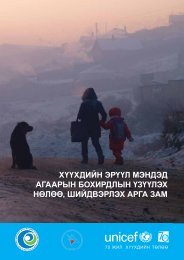FINAL REPORT
2m408P0
2m408P0
Create successful ePaper yourself
Turn your PDF publications into a flip-book with our unique Google optimized e-Paper software.
A study on Menstrual Hygiene Management in Mongolia:<br />
Understanding practices and impacts on adolescent schoolgirls’ education and health<br />
Mongolia has a harsh continental climate, and a prolonged winter with an average temperature of<br />
minus 15–30°C.<br />
The country has a decentralized system of government and is divided administratively into 21<br />
aimags (provinces); each aimag is divided into soums (rural sub-provinces) and baghs (the smallest<br />
administrative unit in rural areas). There are 330 soums and 1,592 baghs. The capital, Ulaanbaatar, is<br />
divided into 9 districts (urban districts), and 152 khoroos (urban sub-districts) 2 .<br />
The rate of urbanization is very rapid in Mongolia. According to 2014 estimates, urban residents make<br />
up 66.4 per cent of the total population (with 45.5 per cent or 1.31 million in Ulaanbaatar) and 65.3<br />
per cent of total households. Internal migration towards cities and urban settlements has increased<br />
since 2000, mainly because herders who have lost their livestock in severe winters (‘dzud’) have<br />
migrated to urban areas in search of alternative livelihoods.<br />
Universally, population migration is considered to have a positive influence on economic development<br />
and to reduce regional imbalances. However, urbanization in Mongolia is accompanied by many<br />
negative impacts, such as over-population in Ulaanbaatar and urban areas, making it difficult to<br />
provide services including a water supply 3 . Most of those who have migrated to urban areas live in<br />
the underserviced ger areas that have limited access to the modern infrastructure enjoyed by their<br />
city-centre counterparts, such as sanitation and piped water.<br />
Figure 2. Unplanned ger districts on the outskirts of Ulaanbaatar<br />
Source: Asia Foundation<br />
2 NSO, Yearbook 2014.<br />
3 Achieving the Millennium Development Goals: Fifth National Progress Report, 2013.<br />
4



